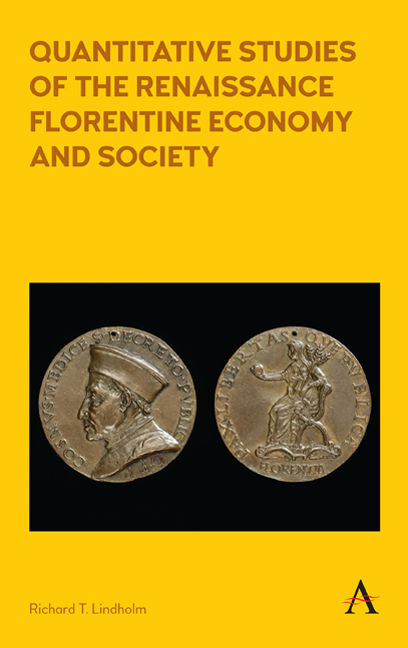Book contents
- Frontmatter
- Dedication
- Contents
- List of Illustrations
- Preface
- Acknowledgments
- List of Abbreviations
- Introduction
- Part I RISKS AND RETURNS
- Part II SOCIETY
- Chapter Three The Chances of Getting Rich in Renaissance Florence: The Wool Industry Occupational Wealth Hierarchy
- Chapter Four Palaces and Workers: Neighborhood Residential Segregation in Renaissance Florence
- Chapter Five The “State” Makes a Work of Art: The Impact of the Catasto Homeowner Tax Loophole on the Quattrocento Florentine Palazzo Building Boom
- Chapter Six Not Getting Ahead in Life: The Lack of Life-Cycle Wealth Accumulation in Quattrocento Tuscany
- Part III WORK
- Conclusion
- Glossary
- Bibliography
- Index
Chapter Five - The “State” Makes a Work of Art: The Impact of the Catasto Homeowner Tax Loophole on the Quattrocento Florentine Palazzo Building Boom
from Part II - SOCIETY
Published online by Cambridge University Press: 10 January 2018
- Frontmatter
- Dedication
- Contents
- List of Illustrations
- Preface
- Acknowledgments
- List of Abbreviations
- Introduction
- Part I RISKS AND RETURNS
- Part II SOCIETY
- Chapter Three The Chances of Getting Rich in Renaissance Florence: The Wool Industry Occupational Wealth Hierarchy
- Chapter Four Palaces and Workers: Neighborhood Residential Segregation in Renaissance Florence
- Chapter Five The “State” Makes a Work of Art: The Impact of the Catasto Homeowner Tax Loophole on the Quattrocento Florentine Palazzo Building Boom
- Chapter Six Not Getting Ahead in Life: The Lack of Life-Cycle Wealth Accumulation in Quattrocento Tuscany
- Part III WORK
- Conclusion
- Glossary
- Bibliography
- Index
Summary
Introduction
Florence is world famous in large part for its private palaces constructed during a Quattrocento building boom that ranks as one of the great events in art and architectural history. The results of this boom probably were part of what inspired Burckhardt to coin his famous phrase “the state as a work of art.” He writes that there was a thorough reconceptualization of the state during the Renaissance, which led to greater equality. More recent economic and social historians debate whether this building boom was associated with an economic depression, exacerbated class divisions or was a significant and productive stimulant to the economy.
The question remains, though, why were the private palaces constructed, and why were they constructed at that time? The study in this chapter provides evidence that a tax exemption in the Quattrocento catasti that subsidized homeownership explains the timing of the palace building as well as a simultaneous increase in the Florentine homeownership rate. Government interventions can have a major impact on homeownership rates. For example, in recent research, economic historians credit effective government intervention with safeguarding American homeownership after the Great Depression began. This study places Florentine palace construction in the long history of impacts from government interventions in the housing market. The approach analyzes Florentine tax policy from a comparatively unusual perspective for Renaissance historiography. Most similar studies measure the aggregate burden to either the entire population or to some subset. This one, however, focuses on the changing relative tax burden. Examining the relative rather than the absolute burden shifts the analysis to the impact of changing incentives on Florentine behavior.
The rest of this chapter develops this argument supporting the subsidy explanation. The timing fits the explanation: the palace-building boom happened at the same time as a striking increase in homeownership. An expanded access to homeownership also fits the explanation, as a wide range of measures shows that Florentines with less wealth and social status joined the ranks of the homeowners. Appendix 4A presents and discusses an opportunity cost model of homeownership that places the various possible explanations into a consistent and mathematical context.
Explaining the Palace-Building Boom
The study presented in this chapter focuses on the homeownership subsidy explanation of the palace-building boom. Other potential explanations include conspicuous consumption, decreased interest rates, increased population and increased wealth.
- Type
- Chapter
- Information
- Publisher: Anthem PressPrint publication year: 2017



